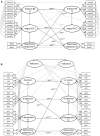Long-Term Associations of Justice Sensitivity, Rejection Sensitivity, and Depressive Symptoms in Children and Adolescents
- PMID: 28955257
- PMCID: PMC5601073
- DOI: 10.3389/fpsyg.2017.01446
Long-Term Associations of Justice Sensitivity, Rejection Sensitivity, and Depressive Symptoms in Children and Adolescents
Abstract
Depressive symptoms have been related to anxious rejection sensitivity, but little is known about relations with angry rejection sensitivity and justice sensitivity. We measured rejection sensitivity, justice sensitivity, and depressive symptoms in 1,665 9-to-21-year olds at two points of measurement. Participants with high T1 levels of depressive symptoms reported higher anxious and angry rejection sensitivity and higher justice sensitivity than controls at T1 and T2. T1 rejection, but not justice sensitivity predicted T2 depressive symptoms; high victim justice sensitivity, however, added to the stabilization of depressive symptoms. T1 depressive symptoms positively predicted T2 anxious and angry rejection and victim justice sensitivity. Hence, sensitivity toward negative social cues may be cause and consequence of depressive symptoms and requires consideration in cognitive-behavioral treatment of depression.
Keywords: adolescence; childhood; depressive symptoms; justice sensitivity; rejection sensitivity.
Figures


Similar articles
-
Justice and rejection sensitivity in children and adolescents with ADHD symptoms.Eur Child Adolesc Psychiatry. 2015 Feb;24(2):185-98. doi: 10.1007/s00787-014-0560-9. Epub 2014 May 31. Eur Child Adolesc Psychiatry. 2015. PMID: 24878677
-
Justice sensitivity and rejection sensitivity as predictors and outcomes of eating disorder pathology: A 5-year longitudinal study.Int J Eat Disord. 2020 Jun;53(6):926-936. doi: 10.1002/eat.23273. Epub 2020 Apr 9. Int J Eat Disord. 2020. PMID: 32270541
-
Links of justice and rejection sensitivity with aggression in childhood and adolescence.Aggress Behav. 2015 Jul-Aug;41(4):353-68. doi: 10.1002/ab.21556. Epub 2014 Aug 18. Aggress Behav. 2015. PMID: 25136820
-
A Longitudinal Rejection Sensitivity Model of Depression and Aggression: Unique Roles of Anxiety, Anger, Blame, Withdrawal and Retribution.J Abnorm Child Psychol. 2016 Oct;44(7):1291-307. doi: 10.1007/s10802-016-0127-y. J Abnorm Child Psychol. 2016. PMID: 26816212
-
Interactions between rejection sensitivity and supportive relationships in the prediction of adolescents' internalizing difficulties.J Youth Adolesc. 2010 May;39(5):563-74. doi: 10.1007/s10964-010-9519-4. Epub 2010 Mar 6. J Youth Adolesc. 2010. PMID: 20213482 Free PMC article.
Cited by
-
Victim Sensitivity and Its Neural Correlates Among Patients With Major Depressive Disorder.Front Psychiatry. 2020 Aug 11;11:622. doi: 10.3389/fpsyt.2020.00622. eCollection 2020. Front Psychiatry. 2020. PMID: 32848898 Free PMC article.
-
Responses Toward Injustice Shaped by Justice Sensitivity - Evidence From Germany.Front Psychol. 2022 Aug 10;13:858291. doi: 10.3389/fpsyg.2022.858291. eCollection 2022. Front Psychol. 2022. PMID: 36033064 Free PMC article.
-
The Relationship of Rejection Sensitivity to Depressive Symptoms in Adolescence: The Indirect Effect of Perceived Social Acceptance by Peers.Behav Sci (Basel). 2023 Dec 22;14(1):10. doi: 10.3390/bs14010010. Behav Sci (Basel). 2023. PMID: 38247662 Free PMC article.
-
Moral emotions and auditory verbal hallucinations in schizophrenia.Schizophrenia (Heidelb). 2025 Feb 15;11(1):18. doi: 10.1038/s41537-025-00574-5. Schizophrenia (Heidelb). 2025. PMID: 39955286 Free PMC article. Review.
References
-
- Abramson L. Y., Metalsky G. I., Alloy L. B. (1989). Hopelessness depression: a theory-based subtype of depression. Psychol. Rev. 96 358–372. 10.1037//0033-295X.96.2.358 - DOI
-
- American Psychiatric Association [APA] (2013). Diagnostic and Statistical Manual of Mental Disorders – DSM-V. Washington, DC: American Psychiatric Association; 10.1176/appi.books.9780890425596 - DOI
LinkOut - more resources
Full Text Sources
Other Literature Sources

